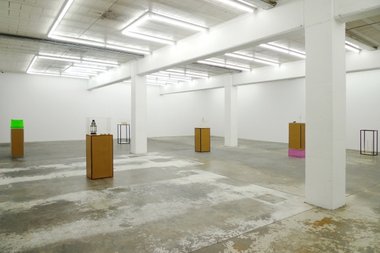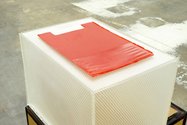John Hurrell – 22 March, 2013
Looking at each cast work, is one always a copy of the other in the pair, or are the two identical sculptures conceptually different - assuming that at this point in time, both happen to exist physically? And if casting results in a facsimile of a sculpture then does that chronological sequencing of events generate a hierarchy where they are not the same?
In what was until recently two separate spaces in Michael Lett’s - but which is now one (the dividing wall has been removed) - Hany Armanious is now presenting seven vertically rectangular sculptures. They look like small towers or from a distance, stacks of carefully aligned cardboard cartons, or toy skyscrapers. Closer inspection makes you think they are really perhaps store-bought readymades, Perspex plinths maybe with their outer, brown paper, protective lining not yet peeled off their clear oblong planes - with other stranger items placed on top or inside.
In fact they (the whole show) are reproducible casts of pigmented polyurethane resin. Every detail of every peculiar component, no matter how seemingly imperfect, accidental or unique, can be duplicated. What you see is most definitely not what you get. The slick ones look like industrial readymades and the wonky ones look like handcrafted oncers: but actually they are all cast. Reproducible editions deliberately restricted to two ‘copies’ only - though both not necessarily in existence yet.
Australian artists have been intrigued by the connected themes of duplication, replication, appropriation and mass reproduction for a long time - at least since Spring 1983 when Art & Text presented an English translation of Jean Baudrillard‘s ‘The Precession of Simulacra’ that was originally published in France in 1978. A couple of months earlier the American journal October published a related article by Gilles Deleuze, ‘Plato and the Simulacrum.’
Thinking of Plato but looking at Armanious - wondering about each work listed in the Michael Lett catalogue - is one a copy of the other in the pair, or are the two cast sculptures conceptually different - assuming that at this point in time, both happen to exist physically? And if casting results in a facsimile of a sculpture then does that chronological sequencing of events generate a hierarchy where they are not the same? If they both could be manufactured simultaneously would they now be identical? Yet as separate spatially located forms and as isolated cohesive identities, they are two. They must be different.
Perhaps the Armanious works can be thought of as similar to writings in the often-referenced Borges story Pierre Menard, Author of the Quixote, where Cervantes’ text is compared with Menard’s, revealing that the texts’ difference in chronology and cultural context ends up establishing distinctions.
As for the process of casting itself - its significance as a method - this has long been scrutinised by critics like Rosalind Krauss (in her discussions of Rodin‘s ‘original’ bronzes and posthumous editions), pointing out issues that are sometimes also raised in this country in relation to the Len Lye Foundation. If Armanious were to die and these works only had single (if any) copies existing, could other casts be produced as ‘authentic’ artworks in his absence?
For another scenario, what if the casts got destroyed and no more replicas were possible? That would affect the meaning of the work because of the indexical duplicating processes disappearing. This would make each sculpture a unique object, one displaying mimetic qualities that cannot be repeated, attributes that are nevertheless admired technically for their precision and detail. The work is thought about differently.
In this exhibition the role of the plinth is also examined by Armanious, teasing out a lack of distinction between sculpture and any physical support (or institution provided base) required to raise it to eye height. In some ways Armanious is similar to the French artist Bertrand Lavier who for many years has methodically explored the notion of ‘support’ by covering cars, aqualungs and other objects with thick coats of colour-matching oil paint, and creating sculpture by positioning fridges on safes, or electric pianos on big freezers. Plinth and sculpture become interchangeable.
As with Lavier, Armanious’s sculpture toys with museum conventions. It goes down to the floor but pretends to stop at chest height. Though cast, it seems individually cut out of acrylic sheets and bent or glued into shape, confounding the investigating eye. The work relies on language to make its point, because its production method is not self-evident. It is not visually detectable, an aspect I personally think diminishes it as art. The fact you need to be told.
John Hurrell










 Two Rooms presents a program of residencies and projects
Two Rooms presents a program of residencies and projects Advertising in this column
Advertising in this column



This Discussion has 0 comments.
Comment
Participate
Register to Participate.
Sign in
Sign in to an existing account.